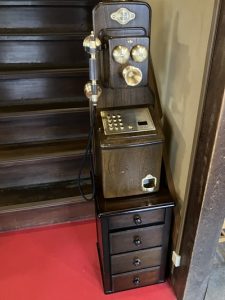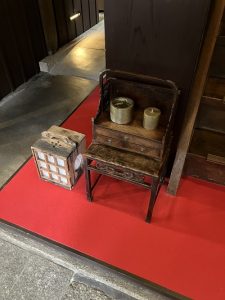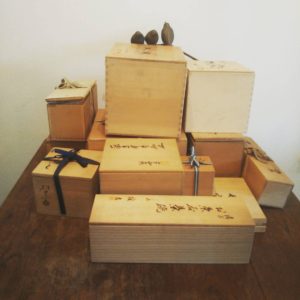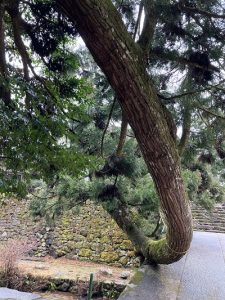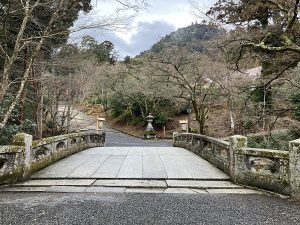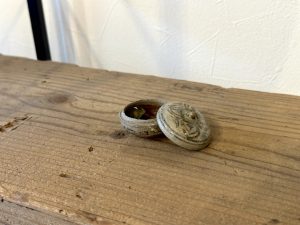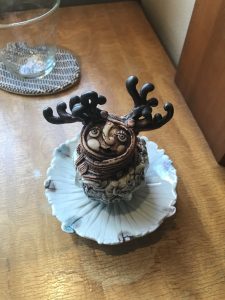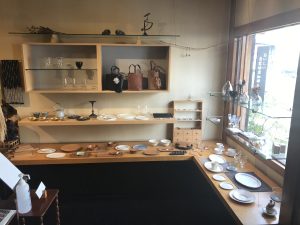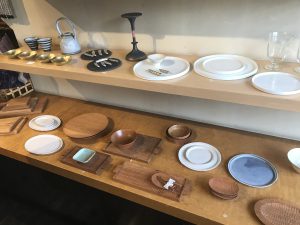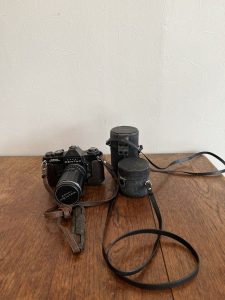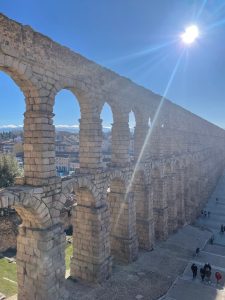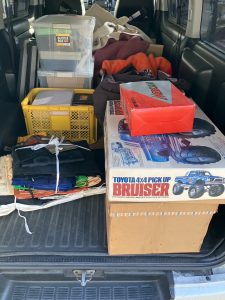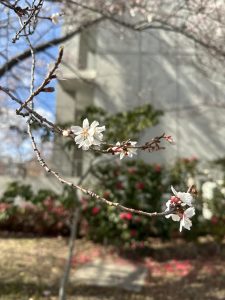2月22日は猫の日(愛知県名古屋市千種区姫池通 骨董買取致します 古美術風光舎)
2023.02.22
皆さま、こんにちは。スタッフMです。
昨日は冷たくて強い風が吹き荒れていて、2月らしい寒さが戻ってきていましたね。
かわって本日は太陽の日差しが暖かく昨日よりは過ごしやすいです。
最近は日中暖かい日が多く、気持ち的には春のような…たまに春の香りが漂う感じお分かりいただけますでしょうか?!
まだ衣替えをするには早いのですが、少し薄手の服をクローゼットの奥から取り出し着てみたところ、店主にまだ早いと言われてしまいました(笑)確かにすごく寒かったんです。気ばかり早まってしまい、やはりまだ厚着のセーターを着る季節だったなと実感いたしました。
さて、本日2月22日は猫の日。

ということで、ブログを読んでいただいてる方でしたらご存知の方も多くいらっしゃると思いますが、当店は猫好きスタッフで溢れておりまして・・・
とくにわたくしスタッフMが猫好き代表として本日はブログを綴りたいと思います。(スタッフNも負けていませんが)
実際にうちは現在2匹の保護猫ちゃんと暮らしておりまして、どちらもキジトラ。
1匹は15歳のおじいちゃんで、もう一匹はまだ1歳の赤ちゃんです。
人間で言うと、70代後半のおじいちゃんと、ハタチぐらい女の子で孫と祖父の関係性と言えますね。
少し調べてみると、猫の年齢のギネス認定記録はアメリカのテキサス州で暮らしていた猫ちゃんでなんと38歳3日まで生きたとのこと!!
人間の年齢に換算すると約170歳という驚きの記録です。
是非とも長生きの秘訣を知りたいものです。
そんな長生き猫ちゃんのお話はここらへんにしまして、当店の猫ちゃんといえばお馴染みの2匹。
シュッとしたお顔とブルーの目が印象的なシャム猫と、ぽてっとしたふくよかな体をしたこちらは三毛猫でしょうか。
私はどちらもとっても可愛らしくて好きですが、三毛猫のふてぶてしい感じがうちの子と似ていてなんともたまらなくて愛おしくなります。
猫は古く昔から縁起が良いと言われいて、とくに招き猫のような猫の置物が一家に1匹いるご家庭も多いはず。
身近な存在ではあるものの、その由来や産地などの詳細を知らないという方もいらっしゃるかもしれませんので少し説明させていただきますと・・・
日本各地で作られてきた招き猫ですが、三大産地と呼ばれる瀬戸焼、常滑焼、久谷焼で多く作られてきました。
瀬戸焼の招き猫の特徴は狐顔で、細身、猫背で複数の鈴とひだのある前掛けをつけていることが多いそうです。
そして九谷焼の招き猫は全身極彩色の文様でおおわれ、金彩は施されたりと華やかな見た目が特徴。
最後に、ザ・招き猫と言われる常滑焼の招き猫。目が大きく見開き、丸みのある二頭身に小判を抱えた姿が特徴でこの形の招き猫が皆さまの思い浮かべる招き猫なのではないでしょうか。
招き猫のルーツは諸説あるようですが、その中の1つ東京・世田谷にあります豪徳寺の「招福猫児(まねぎねこ)」説についてご紹介させていただきます。
豪徳寺は今でこそ井伊家の菩提寺ですが、もともとは小さなお寺でした。和尚の飼い猫が、鷹狩り帰りの井伊直孝一行を寺に招き入れた直後、激しい雷雨となり、難を逃れたことを喜んだ直孝が寺を手厚く保護し、寺は井伊家の菩提寺として栄えたという言われれあるのだそうです。
奥が深い招き猫、飾り方や意味など書きたいことはまだまだたくさんありますが、それはまた後日。
今日は仕事が終わりましたら家に直行して猫ちゃんたちに日頃の感謝と労いの気持ちも込めて、チュールでもあげようかなと思います。
ちなみに15歳のおじいちゃん猫はチュールよりカリカリごはん派の健康志向タイプですので、ちょっと美味しいカリカリごはんをあげたいと思います。
では。
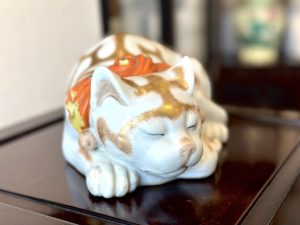
Hello everyone. This is staff M.
The cold and strong wind was blowing yesterday, and the coldness of February was back. On the contrary, today the sunshine is warm and it is easier to spend than yesterday. Recently, there are many warm days in the daytime, and it feels like spring. ! It’s still too early to change clothes, but when I took out some light clothes from the back of the closet and tried them on, the owner said it was too early. I was a bit premature, and I realized that it was still the season to wear thick sweaters.
Today, February 22nd is Cat Day.
So, if you’re reading my blog, I’m sure there are many of you who know, but our store is full of cat-loving staff… In particular, I, Staff M, would like to write a blog today as a representative cat lover. (Although Staff N has not lost)
In fact, we currently live with two rescued cats, both of which are pheasant tigers. One is a 15 year old grandpa and the other is a 1 year old baby. In terms of human beings, the relationship between a grandpa in his late 70s and a grandson who is about the size of a hatachi and a grandfather.
After some research, I found out that the Guinness world record for the age of a cat is a cat that lived in Texas, USA, and lived to be 38 years and 3 days old! ! It is a surprising record of about 170 years old when converted to human age. I would love to know the secret to longevity.
Let’s not talk about such long-lived cats here, but the two familiar cats in our store. Is this a Siamese cat with a striking face and blue eyes, and a calico cat with a plump body? Both of them are very cute and I like them, but the calico cat’s arrogant feeling is similar to my child, and it’s irresistible and endearing.
Cats have been said to bring good luck since ancient times, and many households have at least one cat figurine like a beckoning cat. Although it is familiar to us, there may be some people who do not know the details such as its origin and production area, so let me explain a little…
Manekineko has been made all over Japan, but many of them are made in Seto ware, Tokoname ware, and Kutani ware, which are called the three major production areas. Seto-yaki beckoning cats are characterized by their fox faces, slender bodies, stooped backs, and often wearing multiple bells and pleated aprons. The Kutani ware beckoning cat is covered with richly colored patterns and is decorated with gold, giving it a gorgeous appearance. Lastly, Tokoname-yaki beckoning cat called the beckoning cat. With its eyes wide open and its rounded two-headed body holding an oval gold coin, this shape of beckoning cat is probably the beckoning cat that comes to your mind.
There are various theories about the origin of manekineko, but I would like to introduce one of them, the theory that it is the “Maneki Neko” of Gotokuji Temple in Setagaya, Tokyo. Gotokuji is now the family temple of the Ii family, but it was originally a small temple. Immediately after the priest’s pet cat invited Naotaka Ii, who was returning from falconry, to the temple, there was a severe thunderstorm. It seems that it is said.
There are still many things I want to write about, such as the profound maneki-neko, how to decorate it, and its meaning, but that will be another day. After work today, I think I’ll go straight home and give the cats some tulle to express my gratitude and kindness. By the way, my 15-year-old grandpa cat is a health-conscious type who prefers crunchy rice to tulle, so I would like to give him a little delicious crunchy food.
********************
ご実家の整理やお片付けなどをされている方のご相談などが多くございます。
お寒くなってまいりましたので、お片付けなどくれぐれもご無理のないようになさってくださいませ。
風光舎では古美術品や骨董品の他にも絵画や宝石、趣味のお品など様々なジャンルのものを買受しております。
お片付けをされていて、こういうものでもいいのかしらと迷われているものでも、どうぞお気軽にご相談下さいませ。
また風光舎は、出張買取も強化しております。ご近所はもちろん、愛知県内、岐阜県、三重県その他の県へも出張いたします。
まずは、お電話お待ちしております。
愛知県名古屋市千種区姫池通
骨董 買取【古美術 風光舎 名古屋店】
TEL052(734)8444
10:00-17:00 OPEN
#骨董#高価買取#古い物#家じまい#古美術#生前整理#招き猫#猫#土牛#瀬戸焼#九谷焼#常滑焼

